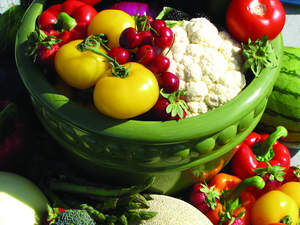MISSION, KS--(Marketwire - April 26, 2010) - (Family Features) Imagine dining on the best-tasting fresh produce around -- and all you had to do was step outside.
From container grown tomatoes to backyard farms, edible gardening is a growing trend. More than 41 million households grew some kind of vegetables, fruits, berries or herbs last year, according to the 2009 Edibles Gardening Trends Research Report conducted by the Garden Writers Association Foundation.
The survey showed that the main reasons people grow their own food include:
- to save money on food bills (54 percent)
- for better quality food (51 percent)
- to grow food they know is safe (48 percent)
If you plan to grow your own produce, here are some things to help you succeed.
Create a Garden Plan
When looking through seed catalogs or eyeing seedlings, it is tempting to get a little bit of everything. But you will have more fun and be more successful with some simple planning. Consider:
Space
- How much room will your plants need to grow? Melons need space to stretch out long vines, while carrots don't take up much room. Will beans need a 5-foot trellis, or grow into 12-inch bushy plants?
- How much room do you have? Do you want a 10 x 10 foot plot, or would a smaller raised bed fit with your outdoor entertaining?
Light
- Most produce needs a minimum of six hours of sunlight in order to thrive. Take a few days figuring out where, when and how long the sun hits your gardening spot.
Plants
- Talk with your family about what they will eat. Pick some favorites to grow, then encourage everyone to try one new vegetable.
- Make a sketch, drawing little circles to represent your plants. Use the spacing recommended on the seed packet or plant tag as a guide.
Investment
- Starting a garden is an investment, so think through your budget. Make a list: potting mix and garden soil, seeds and plants, plant food, and pots or materials for raised beds.
- Consider the time needed to tend your garden. A few hours up front will get you started, then weekly watering, weeding and feeding during the growing season -- and harvesting!
Getting Started
In-Ground Gardening
Preparing the Soil. Think of soil like a house's solid foundation: a garden needs a strong, healthy base. Without good soil, plants can't thrive.
- Mark out your garden, and dig the soil to a depth of six to eight inches. Remove any rocks, debris and weeds. Make sure to get all the weed roots to avoid reappearances.
- Most soil is missing the nutrients that growing plants need. Improve your soil by digging in a mix of organic materials and slow-acting plant food, or by top-dressing with a soil mix made specifically for gardening in-ground or in raised beds. Soils such as Miracle-Gro Garden Soil or Miracle-Gro Moisture Control Garden Soil amend your soil with needed nutrients. Rake a four-inch layer into your garden.
Planting. Spring comes at different times to every part of the country. Usually 60 degrees signals the end of large fluctuations between day and night temperatures. This temperature allows the soil to warm up, which is needed for germination and for young plants to take root and grow healthy, starting the season out right. While you're waiting, you can start some seeds indoors, or try early season plants that do well in cooler temperatures.
- Easy season plants: spinach, salad greens and peas.
- Things to start indoors: tomatoes, peppers, celery, cauliflower, head lettuce, eggplant, broccoli, Brussels sprouts.
- Plants to start indoors or out: beans, peas, most lettuce, and corn.
- Root plants for only outdoors: carrots, turnips, potatoes, parsnips, etc.
Once your seeds start to sprout, give baby plants a little extra room by transplanting into bigger pots. Then help the transition with a taste of the great outdoors by putting the seedlings outside for a few hours at a time. This helps the plants get used to the new environment without suffering shock. To help prevent transplant shock and stimulate root growth, use a starting solution such as Miracle-Gro QuickStart.
Feeding and Watering
Even though the soil surface is wet or dry, you can't always tell what's going on below. Stick a long screwdriver into your garden soil. If it goes in easily, you've watered enough. Or purchase a moisture meter. To water effectively, do it:
- after planting
- before leaves wilt
- in the morning
Once plants are established, make watering and feeding a regular routine. Just like your body needs nourishment, fertilizing -- or feeding -- plants helps supplement the nutrients that the soil lacks, and encourages a bountiful harvest. Direct water and plant food at the base of the plant. Try plant foods such as Miracle-Gro Shake 'n Feed All-Purpose Plant Food, which continuously feeds your plants for up to 3 months, or feed and water at the same time through leaves and roots with a product like Miracle-Gro LiquaFeed.
Enjoying the Harvest
Consider planting an extra plant or row of crops for your local food bank. Many food pantries don't always offer fresh produce. Check to see what is needed and if your food bank takes produce donations. To locate a food bank near you, visit feedingamerica.org.
For more garden tips, videos and ideas, go to miraclegro.com.
